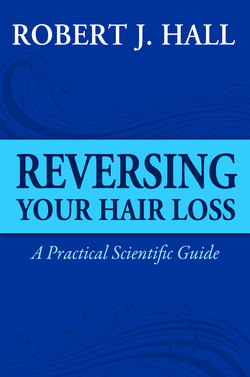Читать книгу Reversing Your Hair Loss - A Practical Scientific Guide - Robert J. Hall - Страница 11
На сайте Литреса книга снята с продажи.
Chapter Seven Sebum
ОглавлениеSebum is a word that comes from the Latin for tallow (animal fat). Sebum itself is the ‘oil’ that is continually secreted from the sebaceous gland attached to the follicle of terminal hairs. This oil gets discharged into the follicular canal and then seeps out from it over the skin and up the hair shaft. Grooming behaviour in both animal and humans is designed to ensure the greatest distribution of this oil. Sebum keeps the skin and hair both water-repellent and moisturised. It does this by acting like a waterproof barrier over the skin, keeping internal moisture within the skin layers and keeping external water away from the epidermis itself. Coupled with the sweat glands, sebum turns the skin into a tightly controlled, semi-permeable membrane.
Sebaceous glands and the follicles cover virtually the entire body but are concentrated on the face and scalp as well as the inner surface of the ear canals. They are always absent from the lips, the palms of the hands and the soles of the feet, however.
Although an oil-based secretion, sebum’s formulation differs depending upon its location and, more importantly, its function at that location. Earwax (also called cerumen) is largely composed of sebum, for instance, as is the far more fluid and colourless oil that is secreted across the surface of each eye. This oily film floats on the top of the tear fluid itself to prevent its too-rapid evaporation.
The composition of sebum can be easily altered in this way because it is not a single chemical substance at all; it is actually composed from an assortment of them. ‘Normal’ sebum contains water, triglycerides, fats, waxes, squalane and various other substances including natural antibiotic enzymes, vitamin E (a fat-soluble antioxidant) and pheromones. By simply varying the proportions of these components the various types of sebum ranging from the heavy waxes to the far lighter tear-oil are arrived at.
Sebum itself is odourless and what we think of as its characteristic smell is actually one brought about through both its oxidation and the action of bacteria and fungi (yeasts) feeding upon it. This bacterial action, in particular, is also a prime cause of acne.
Sebum has always been believed to be somehow involved in hair-loss. Its exact position within the chain of events, however, depends upon what you believe the principal causative agent to be. The nature of these causative agents is discussed later. Suffice to say that the reputation of sebum as some sort of necessary nuisance is entirely undeserved.
